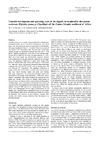Identificador persistente para citar o vincular este elemento:
https://accedacris.ulpgc.es/jspui/handle/10553/609
| Título: | Gonadal development and spawning cycle in the digynic hermaphrodite sharpsnout seabream Diplodus puntazzo (Sparidae) off the Canary Islands, Northwest of Africa | Autores/as: | Lorenzo Nespereira, José María Gonzalez-Pajuelo, Jose Mario Domínguez-Seoane, Rosa |
Clasificación UNESCO: | 240114-4 Taxonomía animal. Peces 2401 Biología animal (zoología) |
Palabras clave: | Sargo picudo (Peces) Ecofisiología Canarias |
Fecha de publicación: | 2008 | Publicación seriada: | Journal of Applied Ichthyology | Resumen: | Diplodus puntazzo is a species characterized by a rudimentary hermaphroditism, with a low level of protandry. The study found that the overall sex ratio was one male to 2.03 females, diverging significantly from 1 : 1, and that there was a ratio of one male to 0.11 transitional fish. The sex ratio varied with season: during the reproductive period the ratio was 1 : 1.86 (male : female), significantly lower than in the non-reproductive period in which the sex ratio was approximately 1 : 2.26. Both sexes had similar size distributions; however, females were predominant in all size intervals, especially in the larger ones. No significant difference in mean total length (TL) between females (330 mm), males (319 mm) or transitionals (321 mm) was found. The smallest functional female and male analysed were 159 and 157 mm TL, and the largest were 520 and 510 mm TL, respectively. No significant difference in length at first level of maturity, attained at the second year of life, was found between males (281 mm) and females (292 mm), respectively. A protracted spawning season was identified for the species: from September to February, with a peak in November. GSI values followed the same pattern for males and females, with values of females being similar to those of males; the highest values occurred between September and December, with a maximum in November. Occurrence of transitional fish was significantly higher during the month with highest values of GSI than in the resting period. The study found that vitellogenesis did not begin synchronously for all females, and the simultaneous presence of oocytes in all stages of development indicated an asynchronous mode of ovarian development. The presence of postovulatory, together with tertiary yolk vesicle oocytes, indicated that the species is a multiple spawner. | URI: | https://accedacris.ulpgc.es/handle/10553/609 | ISBN: | 1758659 | ISSN: | 0175-8659 | DOI: | 10.1111/j.1439-0426.2007.01010.x | Fuente: | Journal of Applied Ichthyology [ISSN 0175-8659], v. 24 (1), p. 68-76, (Febrero 2008) |
| Colección: | Artículos |
Citas SCOPUSTM
44
actualizado el 08-jun-2025
Citas de WEB OF SCIENCETM
Citations
36
actualizado el 08-jun-2025
Visitas
96
actualizado el 13-jul-2024
Descargas
165
actualizado el 13-jul-2024
Google ScholarTM
Verifica
Altmetric
Comparte
Exporta metadatos
Los elementos en ULPGC accedaCRIS están protegidos por derechos de autor con todos los derechos reservados, a menos que se indique lo contrario.
